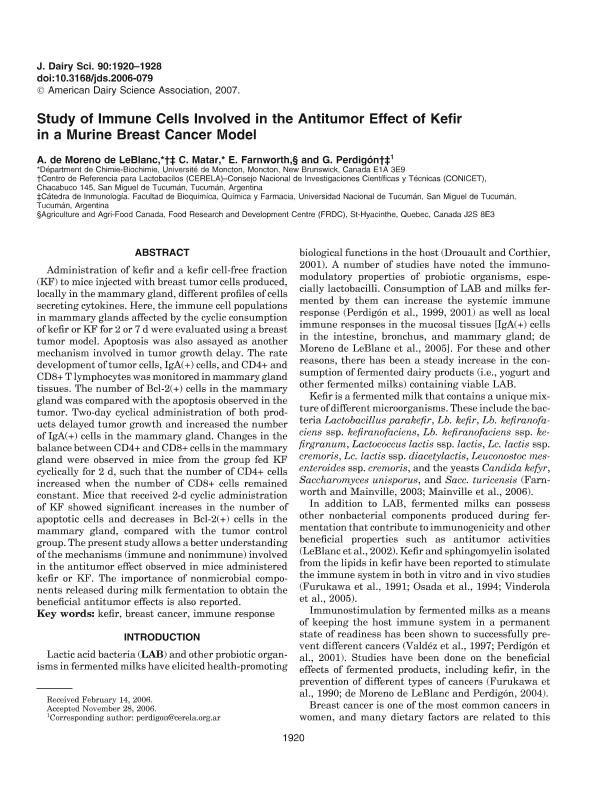Mostrar el registro sencillo del ítem
dc.contributor.author
de Moreno, Maria Alejandra

dc.contributor.author
Matar, Chantal
dc.contributor.author
Farnworth, Edward
dc.contributor.author
Perdigon, Gabriela del Valle

dc.date.available
2018-09-06T19:07:55Z
dc.date.issued
2007-04
dc.identifier.citation
de Moreno, Maria Alejandra; Matar, Chantal; Farnworth, Edward; Perdigon, Gabriela del Valle; Study of immune cells involved in the antitumor effect of kefir in a murine breast cancer model; American Dairy Science Association; Journal of Dairy Science; 90; 4; 4-2007; 1920-1928
dc.identifier.issn
0022-0302
dc.identifier.uri
http://hdl.handle.net/11336/58581
dc.description.abstract
Administration of kefir and a kefir cell-free fraction (KF) to mice injected with breast tumor cells produced, locally in the mammary gland, different profiles of cells secreting cytokines. Here, the immune cell populations in mammary glands affected by the cyclic consumption of kefir or KF for 2 or 7 d were evaluated using a breast tumor model. Apoptosis was also assayed as another mechanism involved in tumor growth delay. The rate development of tumor cells, IgA(+) cells, and CD4+ and CD8+ T lymphocytes was monitored in mammary gland tissues. The number of Bcl-2(+) cells in the mammary gland was compared with the apoptosis observed in the tumor. Two-day cyclical administration of both products delayed tumor growth and increased the number of IgA(+) cells in the mammary gland. Changes in the balance between CD4+ and CD8+ cells in the mammary gland were observed in mice from the group fed KF cyclically for 2 d, such that the number of CD4+ cells increased when the number of CD8+ cells remained constant. Mice that received 2-d cyclic administration of KF showed significant increases in the number of apoptotic cells and decreases in Bcl-2(+) cells in the mammary gland, compared with the tumor control group. The present study allows a better understanding of the mechanisms (immune and nonimmune) involved in the antitumor effect observed in mice administered kefir or KF. The importance of nonmicrobial components released during milk fermentation to obtain the beneficial antitumor effects is also reported.
dc.format
application/pdf
dc.language.iso
eng
dc.publisher
American Dairy Science Association

dc.rights
info:eu-repo/semantics/openAccess
dc.rights.uri
https://creativecommons.org/licenses/by-nc-sa/2.5/ar/
dc.subject
Breast Cancer
dc.subject
Immune Response
dc.subject
Kefir
dc.subject.classification
Inmunología

dc.subject.classification
Medicina Básica

dc.subject.classification
CIENCIAS MÉDICAS Y DE LA SALUD

dc.title
Study of immune cells involved in the antitumor effect of kefir in a murine breast cancer model
dc.type
info:eu-repo/semantics/article
dc.type
info:ar-repo/semantics/artículo
dc.type
info:eu-repo/semantics/publishedVersion
dc.date.updated
2018-07-30T15:21:13Z
dc.identifier.eissn
1525-3198
dc.journal.volume
90
dc.journal.number
4
dc.journal.pagination
1920-1928
dc.journal.pais
Estados Unidos

dc.journal.ciudad
Champaign
dc.description.fil
Fil: de Moreno, Maria Alejandra. Consejo Nacional de Investigaciones Científicas y Técnicas. Centro Científico Tecnológico Conicet - Tucumán. Centro de Referencia para Lactobacilos; Argentina. Université de Moncton; Canadá. Universidad Nacional de Tucumán; Argentina
dc.description.fil
Fil: Matar, Chantal. Université de Moncton; Canadá
dc.description.fil
Fil: Farnworth, Edward. Food Research and Development Centre. Agriculture and Agri-Food; Canadá
dc.description.fil
Fil: Perdigon, Gabriela del Valle. Consejo Nacional de Investigaciones Científicas y Técnicas. Centro Científico Tecnológico Conicet - Tucumán. Centro de Referencia para Lactobacilos; Argentina. Universidad Nacional de Tucumán. Facultad de Bioquímica, Química y Farmacia; Argentina
dc.journal.title
Journal of Dairy Science

dc.relation.alternativeid
info:eu-repo/semantics/altIdentifier/doi/http://dx.doi.org/10.3168/jds.2006-079
dc.relation.alternativeid
info:eu-repo/semantics/altIdentifier/url/https://www.sciencedirect.com/science/article/pii/S0022030207716788
Archivos asociados
